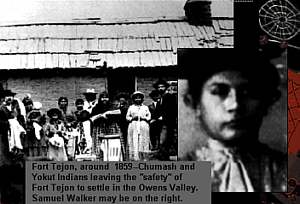|
|

"Ever
since Mnemosyne, the mother of the muses, gave the wax tablet to mortals,
memory, writing and technology have been interconnected. "
All thumbnails link to larger, high quality versions of Califia's illustrations. All images are from M. D. Coverley's Califia (Eastgate Systems, in press). Reproduced by permission of Eastgate Systems. 
|
Three-Dimensional
Dementia 6 Califia is an experience that requires the building of associational worlds in the memory as an active assembling of the reading process. A lack of logical structuring also encourages the reader to look at the text (and to listen to its music.) Aesthetics thereby become part of the reading process. "Beauty is a resistant structure" (Kirschenbaum n.p.), and this means that the reader cannot reduce, analyse or categorize the images. They must be experienced on an emotional level. And like Alzheimer's Disease, aesthetics are a private, personal system--an indecipherable, associational code. The sensory experience of the images and texts-as-images (for the line blurs in a narrative like this) also become part of the voyagings of the plot because the clues are never hierarchical or purely textual. Navigation of the narrative environment ensures physical grounding in the present moment and activates the proprioceptive sense, but the reading of text and image sets a reader adrift in the spatio-temporal dimension. The dementia inherent in variable space and time is embodied in conflicting memories of the same events and in oral forms of storytelling. Rosalind Summerland, for example, recounts two versions of the shooting of Augusta's father: "One version," she says, is what I believed at the time and continued to consider the official family account. Another has all the later revelations, the elements that fill in the spaces, answering questions we did not want to ask (North: Point 4). All of the family legends evidence the same split: they are "the wishful thinking of a bunch of eccentrics. The treasures might be priceless or worthless depending on your faith in the long shot" (South: Augusta 3). It is significant that Califia is not a history, but instead a genealogy--for a genealogy embraces the personal (Foucault 156). This hypertext privileges the familial and the unofficial, and subjective narratives are contrasted by the presence of official histories and 'objective' perspectives like maps, legal documents and uncensored accounts of the greed and racism that led to the oppression and eventual extinction of the native people known as the Chumash. 1
| 2 | 3 | 4
| 5 | 6 | 7 | 8
| Sources
|
||
